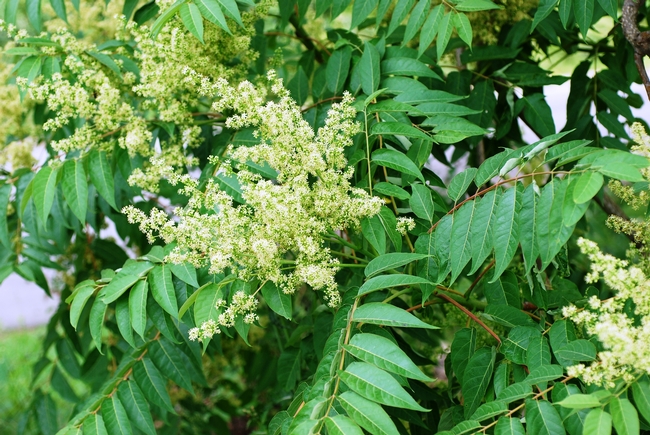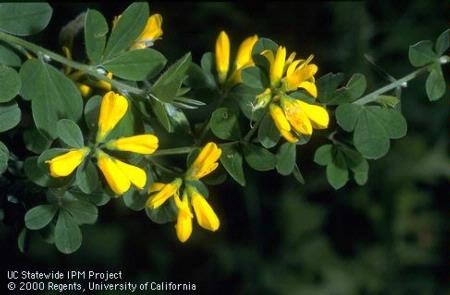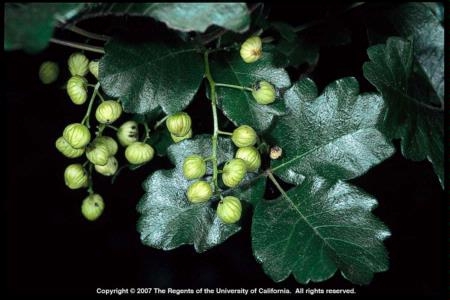Invasive plants are defined by the Natural Resource Conservation Service (NRCS) as, “A plant that is both non-native and able to establish on many sites, grow quickly, and spread to the point of disrupting plant communities or ecosystems.” Depending on the location of your forest or oak woodland, this includes plants such as Scotch broom, cheatgrass, Tree-of-Heaven, pampas grass, and Himalayan blackberry. But for forest or oak woodland landowners who are looking to manage vegetation, there are also native plants that may be less desirable. The NRCS calls these either “Opportunistic native plants or weeds”. Opportunistic native plants, as defined by the NRCS, are able to take advantage of disturbance to the soil or existing vegetation to spread quickly and out-compete the other plants on the disturbed site, such as mountain misery. Weeds are defined as native plants that are not valued in the place where they are growing, or any plant that poses a major threat to agriculture and/or natural ecosystems such as Pacific poison oak.
Photo of Tree of Heaven with flowers
For any landowner, eradication of invasive plants is most effective when the infestation is small or localized. When an infestation covers large areas, you are more often than not, looking at controlling spread versus eradication.
Heather Morrison, a Registered Professional Forester (RPF) and licensed Pesticide Control Advisor, says, “Many times using herbicides in conjunction with other types of vegetation management, like mechanical or burning, can increase the efficacy of the treatments.”
We asked Heather about using herbicides to control invasive species and as a compliment to other vegetation management activities.
Q: Heather, how do you broach the subject of herbicide use with forest landowners?
A: I actually don't treat it any different than any other vegetation management scheme. It is one of the tools we can use and is most definitely a huge part of IPM (Integrated pest management). I present it as an option and if landowners are hesitance, we have a conversation about it. Herbicide isn't always the best choice and every situation is different.
Q: What are some examples where you have effectively used herbicides as a forest management tool?
A: One of the best uses is in shaded fuel breaks. Maintenance is key! People always seem to forget that the forest isn't static and it grows back, so these huge investments we make in establishing fuel breaks can be lost if we don't maintain them.
Another example is invasive plant suppression. Wildfires have been creating the perfect environment for increased spread of invasive plants like broom, pepper wood and stinkwort. The past two years I have been working with some forest landowners in the Glass Fire footprint to suppress French broom which was bad before the fire, and now is even worse. Because new plants take 2-3 years to produce viable seed, it has been a race to try and treat these areas before they release more seed. Broom plants produce thousands of seed per plant which remain viable in the soil for 70+ years!
Photo of scotch broom with flowers
Q: Are there situations where you would NOT recommend using herbicides?
A: Obviously if you are an organic farmer! Mostly what I find is you have to switch up the types of herbicides you use and the application method. Herbicides are very regulated and I like to remind people that we are applying usually only ounces per acre. This is compared to the same herbicides on the shelves where most likely consumers are not reading the label, wearing their Personal Protective Equipment (PPE) or applying the herbicide correctly.
Please note, the US Forest Service's “Forest Management Handbook” recommends that forest landowners who need to treat more than 1/10 acre with herbicides, should consult with an RPF, Certified Pesticide Applicator, or a licensed Pesticide Control Advisor.
For more information on Integrated Pest Management and invasive plant identification, please visit the UC IPM website.
To read more of our interview with Heather and herbicide application safety, as well as information on other mechanical and physical methods of invasive plant management, download the Forest Stewardship Education Newsletter, June 2022.
To learn more about forest stewardship, vegetation management and forest pests, download the UC Forest Stewardship Series.
Photo of Pacific poison oak with berries


